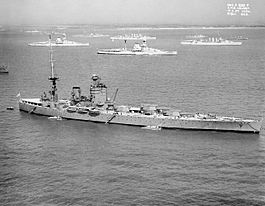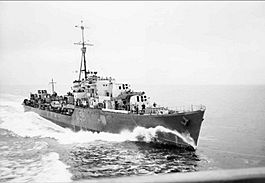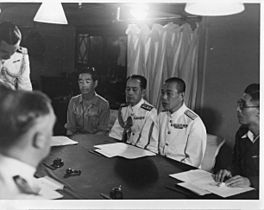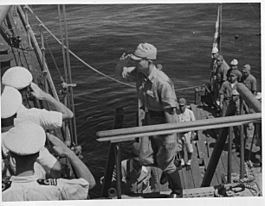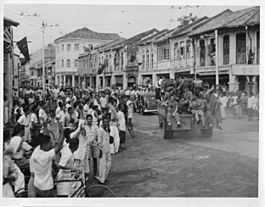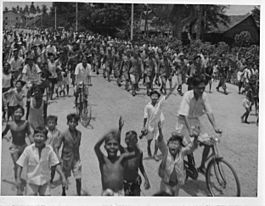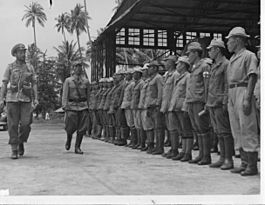Operation Jurist facts for kids
Quick facts for kids Operation Jurist |
|||||||||
|---|---|---|---|---|---|---|---|---|---|
| Part of the Second World War | |||||||||
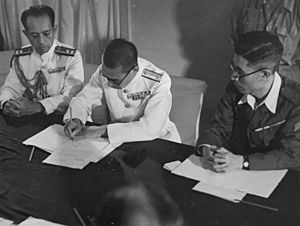 Imperial Japanese Navy Rear Admiral Jisaku Uozumi signs the surrender of Penang aboard HMS Nelson on 2 September 1945. He fainted shortly afterwards and was rushed to hospital. |
|||||||||
|
|||||||||
| Belligerents | |||||||||
| Commanders and leaders | |||||||||
| Units involved | |||||||||
| Strength | |||||||||
| 42,651 infantry 2 escort carriers 1 battleship 1 light cruiser 3 destroyers 3 landing craft |
26,000 infantry | ||||||||
| Casualties and losses | |||||||||
| None | 26,000 captured | ||||||||
Operation Jurist was a plan by the British to take back Penang after Japan surrendered in 1945. It was part of a bigger plan called Operation Zipper. This larger plan aimed to free all of Malaya, including Singapore.
A large group of Allied ships sailed towards Singapore. This was called Operation Tiderace. But a smaller group of Royal Navy warships went to Penang. This group was led by Vice Admiral Harold Walker. They arrived near Penang Island on August 28, 1945.
The Japanese soldiers in Penang surrendered on September 2. The next day, Royal Marine commandos landed on Penang Island. This brought Penang back under British control. Penang was the first place in Malaya to be freed by the British. Singapore was officially surrendered to the British later, on September 12. The rest of Malaya was freed in the weeks that followed.
Contents
Why Operation Jurist Happened
During the last part of World War II, big plans were being made. The Soviet Union invaded Manchuria. The United States was planning a huge invasion of Japan itself. At the same time, the British-led South East Asia Command had just won battles in Burma. They then made plans to take back Japanese-held Malaya. This plan was named Operation Zipper.
The first plan for Operation Zipper was very big. It involved over 100,000 Allied soldiers landing on Malaya's west coast. They aimed to capture important ports like Port Swettenham and Port Dickson. After securing these areas, they would move south to Singapore and north to Penang. The British thought Operation Zipper would start on September 9, 1945. They expected to free Singapore by March 1946.
The Americans did not like the British plan to take back Malaya. They felt it would use too many ships and supplies. These resources were needed for their own planned invasion of Japan, called Operation Downfall. However, the British government believed freeing Singapore was very important. They felt it was necessary for both military and political reasons.
But then, Japan suddenly surrendered. This happened because the Soviets took over Manchuria. Also, the Americans dropped atomic bombs on Hiroshima and Nagasaki. Japan's surrender meant all these big plans had to change.
So, Operation Zipper became much smaller. Most Allied forces went to free Singapore under Operation Tiderace. But a group of Royal Navy ships and Royal Marine commandos were sent to free Penang instead. This mission was called Operation Jurist. Freeing Penang first was a test. The British wanted to see if the Japanese forces in Malaya would surrender peacefully. It was not clear at that time if they would fight on.
Who Was Involved
British Forces
The Royal Navy's Task Force 11 was assigned to Operation Jurist. Here are the ships that were part of it:
| Battleship | HMS Nelson |
| Escort carriers |
|
| Light cruiser | HMS Ceylon |
| Destroyers |
|
| Other vessels: | 3 infantry landing ships |
-
HMS Nelson was the main ship for the Royal Navy's Task Force 11.
-
Royal Navy destroyer HMS Petard.
Vice Admiral Harold Walker was the commander of this group. His main ship was HMS Nelson.
Also, Royal Marine commandos from the 3rd Brigade were the ground troops for Operation Jurist.
Japanese Forces
In Malaya and Sumatra, the Japanese had a little over 170 aircraft.
The Japanese Seventh Area Army was in charge of defending Malaya and Borneo. They had about 26,000 soldiers stationed in Malaya. The port in George Town had been used by Axis submarines. But by then, it was badly damaged from many Allied air raids. The Penang Strait also had mines to stop Japanese ships.
Penang is Freed
The Royal Navy's Task Force 11 left Rangoon, Burma, on August 27, 1945. They were carrying the Royal Marine commandos. The task force arrived near Penang Island on August 28. A small fishing boat with Japanese officers met them.
At first, the Japanese officers in Penang were unsure what to do. Japan's surrender had surprised the Japanese leaders in Singapore. Many of them did not want to give up and wanted to keep fighting. However, Field Marshal Count Terauchi, the top Japanese commander in Southeast Asia, ordered all Japanese soldiers to stop fighting.
Things became urgent when Vice Admiral Walker gave an ultimatum. He demanded that the Japanese officers in Penang sign the surrender papers on his ship by the morning of September 3.
Finally, on the evening of September 2, Imperial Japanese Navy Rear Admiral Jisaku Uozomi boarded HMS Nelson. He was with his officers and the Japanese Governor of Penang, Lieutenant General Shinohara Seiichiro. Inside the battleship, Vice Admiral Harold Walker, Rear Admiral Uozomi, and Lieutenant General Seiichiro signed the surrender of the Japanese forces in Penang. After signing, Rear Admiral Uozomi reportedly fainted and was taken to the hospital.
On the morning of September 3, a group of Royal Marine commandos landed at Weld Quay in George Town. They raised the Union Jack, the British flag. Then, led by a local band, the Royal Marines marched to the Eastern & Oriental Hotel. There, leaders from Penang's Asian communities were waiting. They formally handed the city's control back to the British.
The Royal Marine soldiers then spread out across George Town. They met no resistance. Other Royal Marine groups landed and took over important military places on Penang Island. These included the Bayan Lepas Airport and a seaplane base at Gelugor. The British commandos also took Japanese military vehicles. They marched Japanese prisoners of war through the streets of George Town. The captured Japanese soldiers gave up their weapons. Then they boarded ferries to the mainland of the Malay Peninsula. That part of the mainland was still under Japanese control.
By the end of the day, the island's police force was under British control. George Town became the first city in Malaya to be taken back by the British. However, there were hunger riots across Penang Island. Years of harsh Japanese rule had caused food supplies to run very low.
-
Japanese prisoners of war being marched through the streets of George Town on September 3, 1945.
What Happened Next
Penang was the first state in Malaya to be freed from Japanese rule by the British. In the weeks that followed, the rest of Malaya was also gradually freed. Under Operation Tiderace, a larger British and French naval force arrived near Singapore on September 4. They officially accepted the Japanese surrender of Singapore on September 12.
On September 9, another part of Operation Zipper began. British troops launched an amphibious assault at Morib, Selangor. British soldiers also reached Kuala Lumpur on September 12. The 6,000 Japanese soldiers there surrendered the next day.
However, the British were slow to fully take back control of all of Malaya. For example, British forces did not reach the eastern state of Pahang for another three weeks. This allowed a growing communist group to take over some smaller towns. It was only later in 1945 that the Malayan Communist Party's armed group, the Malayan Peoples' Anti-Japanese Army (MPAJA), agreed to give up their weapons.
To bring back order and control the communists, all of Malaya was placed under British Military Administration. This started on September 12. British military rule ended on April 1, 1946. It was then replaced by the Malayan Union. On the same day, April 1, 1946, the Straits Settlements were dissolved. The now separate British colonies of Penang and Malacca became part of the Malayan Union.


